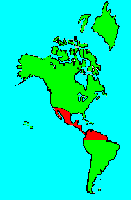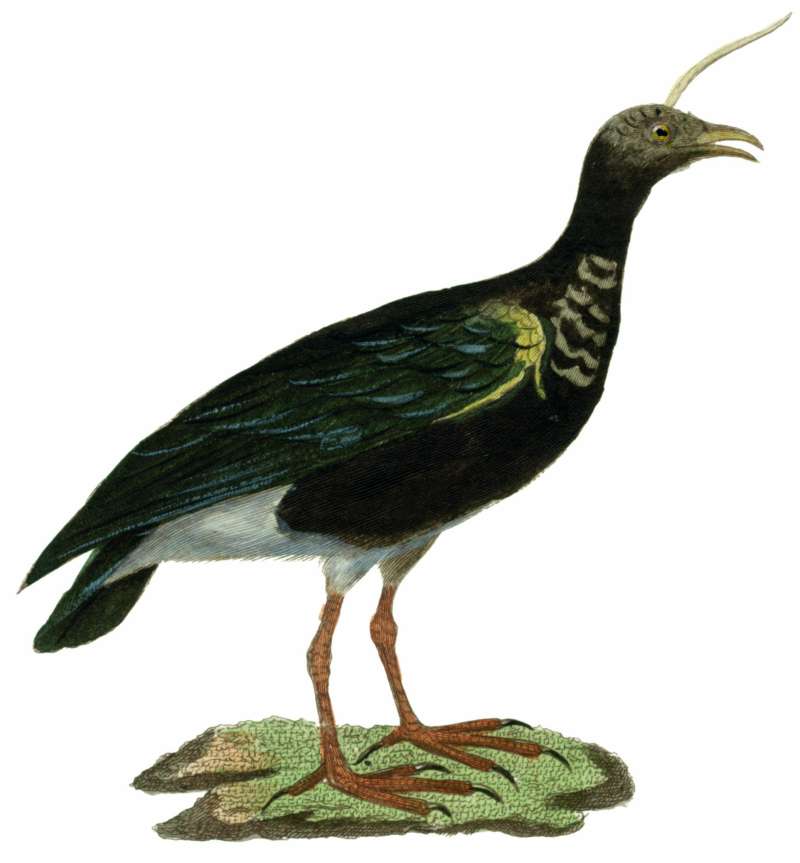SPECIES INFO
Horned Screamer (Anhima cornuta) is found in the northern part of South America. The black coloration, and unusual spire on the head help identify this dark bird which has rather long legs. The lower breast (belly) is white.
There are no subspecies.The horned screamer genus (Anhima) contains a single species found widely east of the Andes in tropical South America. This is a dark colored 34 inch bird with a typical bird like beak even though this lifeform is related to the waterfowl group. There is an unusual slender head horn pointing to the front
Screamer Family (Family Anhimidae) contains three South American species of birds that are found near and on water.
Waterfowl Order (Order Anseriformes) contains three different families of rather divergent appearance and habitat. The South American (Neotropical) Screamers contains three species. The Magpie-Goose family contains one species. And the worldwide ducks and geese (including the whistling ducks) contains about 164 species to total about 168 species in the order. Actually, at least seven of Anseriformes species are recently extinct, and different authors count these differently.
We herein separate the whistling ducks (Dendrocygninidae) into a separate order and family.
The members of this order have three foreward pointing toes that are webbed. The hind toe is free, but very small. The top bill is wide, and the lower bill is smaller. The diving ducks can have narrow bills.
Aves contains about 8,650 different species of living birds known to science. Each year about one new species is discovered in some remote rain forest or remote island. In addition, scientists have been raising many subspecies to full species status which may raise the species count to 10,000. Birdlife recognizes 10,027 species as of 2011.
However, each year about one species goes extinct. The rate of extinction is increasing, and the rate of new discovery is decreasing, so that the number of bird species will soon begin to decline rapidly. Although different taxonomists would organize the birds differently, there are approximately twenty-seven orders of birds. These orders are broken down into about one hundred and fifty-five different families.
Recent research of the genetic structure of some of the shore birds and owls would indicate that the present organization of orders and families should have some modification.
The birds are a worldwide group of animals that are characterized by having the front limbs modified into wings that are used for flying. Perhaps the most unique feature of the birds is the feathers. These feathers are made up of a central support called a quill and a series of small filaments that are hooked together as barbs.
For many years it was believed that Archaeopteryx discovered in Bavaria was the oldest bird from about 150 million years ago. However, in l986, Sankar Chattterjee, a Texas paleontologist, reportedly discovered a bird in the genus Protoavis that lived about 225 million years ago.
When this project was begun in 1978, we used Austin & Singer for bird taxonomy. Since then, we have adopted many changes, but have kept some older concepts that are still found widely in the literature. Recently, we have used Clements and Howard & Moore. Very recently, we have used Monroe and Sibley for the higher taxonomy of the perching birds.
Backboned Animals (Phylum Chordata) are the most advanced group of animals on earth. These animals are characterized by having a spinal cord or backbone. Most members have a clearly defined brain that controls the organism through a spinal cord. Fish, amphibians, reptiles, birds, and mammals are in this phylum.
Currently, some taxonomists believe that the fish should be divided into two groups (sharks and regular fishes) and that there are some other primitive groups in the phylum such as hagfish or lampreys.
Animal Kingdom contains numerous organisms that feed on other animals or plants. Included in the animal kingdom are the lower marine invertebrates such as sponges and corals, the jointed legged animals such as insects and spiders, and the backboned animals such as fish, amphibians, reptiles, birds, and mammals.



